Assessing the Potential of Revegetating Abandoned Agricultural Lands Using Nature-Based Typologies for Urban Thermal Comfort
Abstract
1. Introduction
- How does revegetation with different nature-based typologies influence the thermal comfort of urban dwellers in abandoned urban landscapes?
- What is the potential of abandoned urban agricultural land, once revitalized, to function as strategic green infrastructure for mitigating urban heat stress under high-density urban conditions?
- How can the revitalization of abandoned urban agricultural land contribute to improving key outdoor thermal comfort indicators such as the Universal Thermal Climate Index (UTCI), Standard Effective Temperature (SET*), and Mean Radiant Temperature (Tmrt)?
2. Materials and Methods
2.1. Study Area
2.2. Climatic Data and Model Configuration
2.3. Scenario Design and Experimental Setup
- Scenario (No Vegetation): This scenario serves as the control condition where no vegetation is present. It provides a baseline for comparison to determine how various NBS typologies can influence thermal comfort in urban environments.
- Scenario A (Agricultural Land Typology): This scenario simulates the inclusion of agricultural crops.
- Scenario B1 (Broadleaf Deciduous Trees Typology): This scenario uses broadleaf deciduous trees, such as Quercus spp. as an NBS typology.
- Scenario B2 (Edible Deciduous Trees Typology): This scenario focuses on edible deciduous trees, like fruit-bearing species (e.g., apple trees).
- Scenario C1 (Evergreen Trees Typology): This scenario incorporates evergreen trees, such as Cupressus arizonica, which maintain foliage throughout the year. These trees are widely used in urban horticulture in Iran [49].
- Scenario C2 (Ornamental Conifer) This scenario represents the use of Platycladus orientalis, an ornamental conifer commonly used in Iran’s urban landscapes and for afforestation projects [50].
- Scenario E (Shrubs Typology): Selected based on their ecological adaptability, morphological characteristics, and capacity to enhance urban thermal comfort [4].
2.4. Model Validation and Statistical Performance Metrics
- (1)
- Root Mean Squared Error (RMSE):
- (2)
- Mean Absolute Error (MAE):
- (3)
- Willmott’s Index of Agreement (d):
- Ō: Mean of the observed variable.
- Oi: Observed variables for each instant.
- Pi: Model-predicted variables for each instant.
- n = number of paired observations.
3. Results
3.1. Universal Thermal Climate Index and Standard Effective Temperature
3.2. Mean Radiant Temperature
3.3. Combination Scenario
- Radiative shielding—expanded leaf area index (LAI) intercepts incoming shortwave radiation, reducing direct exposure and lowering Tmrt.
- Evaporative cooling—enhanced transpiration redistributes available energy toward latent heat flux, thus reducing near-surface air temperature and alleviating thermal stress.
- Turbulent modulation—canopy height and porosity regulate airflow and convective heat dissipation, further stabilizing microclimatic conditions.
4. Discussion
4.1. Nature-Based Solution for Solving the Challenge of Climatic Discomfort
4.2. Insights from RayMan and ENVI-Met Simulations
4.3. The Role of Vegetation in Enhancing Thermal Comfort
4.4. Impact on Policy and Practice
4.5. Study Limitations and Strengths
5. Conclusions
Author Contributions
Funding
Data Availability Statement
Acknowledgments
Conflicts of Interest
Abbreviations
| NBS | Nature-Based Solutions |
| UTCI | Universal Thermal Climate Index |
| SET* | Standard Effective Temperature |
| Tmrt | Mean Radiant Temperature |
| PMV | Predicted Mean Vote |
| PET | Physiological Equivalent Temperature |
References
- Ng, E.; Chen, L.; Wang, Y.; Yuan, C. A Study on the Cooling Effects of Greening in a High-Density City: An Experience from Hong Kong. Build. Environ. 2012, 47, 256–271. [Google Scholar] [CrossRef]
- Nasir, R.A.; Ahmad, S.S.; Ahmed, A.Z. Physical Activity and Human Comfort Correlation in an Urban Park in Hot and Humid Conditions. Procedia—Soc. Behav. Sci. 2013, 105, 598–609. [Google Scholar] [CrossRef]
- Talebsafa, S.; Taheri Shahraeini, M.; Yang, X.; Rabiei, M. Impact of Providing Shade on Outdoor Thermal Comfort during Hot Season: A Case Study of a University Campus in Cold Semi-arid Climate. Renew. Energy Res. Appl. 2023, 4, 209–224. [Google Scholar] [CrossRef]
- Rahimi, A.; Nobar, Z. The Impact of Planting Scenarios on Agricultural Productivity and Thermal Comfort in Urban Agriculture Land (Case Study: Tabriz, Iran). Front. Ecol. Evol. 2023, 11, 1048092. [Google Scholar] [CrossRef]
- Crank, P.J.; Sailor, D.J.; Ban-Weiss, G.; Taleghani, M. Evaluating the ENVI-Met Microscale Model for Suitability in Analysis of Targeted Urban Heat Mitigation Strategies. Urban Clim. 2018, 26, 188–197. [Google Scholar] [CrossRef]
- Raymond, C.M.; Frantzeskaki, N.; Kabisch, N.; Berry, P.; Breil, M.; Nita, M.R.; Geneletti, D.; Calfapietra, C. A Framework for Assessing and Implementing the Co-Benefits of Nature-Based Solutions in Urban Areas. Environ. Sci. Policy 2017, 77, 15–24. [Google Scholar] [CrossRef]
- Toxopeus, H.; Kotsila, P.; Conde, M.; Katona, A.; van der Jagt, A.P.N.; Polzin, F. How ‘Just’ Is. Hybrid. Governance of Urban. Nature-Based Solutions? Cities 2020, 105, 102839. [Google Scholar] [CrossRef]
- Pineda-Martos, R.; Calheiros, C.S.C. Nature-Based Solutions in Cities—Contribution of the Portuguese National Association of Green Roofs to Urban Circularity. Circ. Econ. Sustain. 2021, 1, 1019–1035. [Google Scholar] [CrossRef]
- Remme, R.P.; Meacham, M.; Pellowe, K.E.; Andersson, E.; Guerry, A.D.; Janke, B.; Liu, L.; Lonsdorf, E.; Li, M.; Mao, Y.; et al. Aligning Nature-Based Solutions with Ecosystem Services in the Urban Century. Ecosyst. Serv. 2024, 66, 101610. [Google Scholar] [CrossRef]
- Mosca, F.; Perini, K. Nature-Based Solutions for Microclimate Regulation and Human Comfort. In Nature-Based Cities: Performance-Driven Design Approaches for Climate Change Adaptation; Perini, K., Mosca, F., Eds.; Springer Nature: Cham, Switzerland, 2025; pp. 37–55. ISBN 978-3-031-94612-7. [Google Scholar]
- Goličnik Marušić, B.; Dremel, M.; Ravnikar, Ž. A Frame of Understanding to Better Link Nature-Based Solutions and Urban Planning. Environ. Sci. Policy 2023, 146, 47–56. [Google Scholar] [CrossRef]
- Faivre, N.; Fritz, M.; Freitas, T.; de Boissezon, B.; Vandewoestijne, S. Nature-Based Solutions in the EU: Innovating with Nature to Address Social, Economic and Environmental Challenges. Environ. Res. 2017, 159, 509–518. [Google Scholar] [CrossRef]
- Ali-Toudert, F.; Mayer, H. Numerical Study on the Effects of Aspect Ratio and Orientation of an Urban Street Canyon on Outdoor Thermal Comfort in Hot and Dry Climate. Build. Environ. 2006, 41, 94–108. [Google Scholar] [CrossRef]
- Jorgensen, E. URBAN FORESTRY IN THE REARVIEW MIRROR. Arboric. J. 1986, 10, 177–190. [Google Scholar] [CrossRef]
- McPherson, E.G. Chicago’s Urban Forest Ecosystem: Results of the Chicago Urban Forest Climate Project; U.S. Department of Agriculture, Forest Service, Northeastern Forest Experiment Station: Upper Darby, PA, USA, 1994.
- Majidi, A.N.; Vojinovic, Z.; Alves, A.; Weesakul, S.; Sanchez, A.; Boogaard, F.; Kluck, J. Planning Nature-Based Solutions for Urban Flood Reduction and Thermal Comfort Enhancement. Sustainability 2019, 11, 6361. [Google Scholar] [CrossRef]
- Kurban, A.S.; Papparelli, A.H.; Cunsulo, M.E. Aporte de la forestación al control del clima urbano en zona árida. Av. Energías Renov. Medio Ambiente 2002, 6, 43–48. [Google Scholar]
- Zhou, L.; Li, N.; He, Y.; Peng, J.; Wang, C.; A, Y. A Field Survey on Thermal Comfort and Energy Consumption of Traditional Electric Heating Devices (Huo Xiang) for Residents in Regions without Central Heating Systems in China. Energy Build. 2019, 196, 134–144. [Google Scholar] [CrossRef]
- Tsoka, S.; Tsikaloudaki, A.; Theodosiou, T. Analyzing the ENVI-Met Microclimate Model’s Performance and Assessing Cool Materials and Urban Vegetation Applications—A Review. Sustain. Cities Soc. 2018, 43, 55–76. [Google Scholar] [CrossRef]
- Alonzo, M.; Ibsen, P.C.; Locke, D.H. Urban Trees and Cooling: A Review of the Recent Literature (2018 to 2024). Arboric. Urban. For. 2025, 51, 420–444. [Google Scholar] [CrossRef]
- Jänicke, B.; Milošević, D.; Manavvi, S. Review of User-Friendly Models to Improve the Urban Micro-Climate. Atmosphere 2021, 12, 1291. [Google Scholar] [CrossRef]
- Budzik, G.; Sylla, M.; Kowalczyk, T. Understanding Urban Cooling of Blue–Green Infrastructure: A Review of Spatial Data and Sustainable Planning Optimization Methods for Mitigating Urban Heat Islands. Sustainability 2024, 17, 142. [Google Scholar] [CrossRef]
- Wang, Y.; Bakker, F.; De Groot, R.; Wortche, H.; Leemans, R. Effects of Urban Trees on Local Outdoor Microclimate: Synthesizing Field Measurements by Numerical Modelling. Urban Ecosyst. 2015, 18, 1305–1331. [Google Scholar] [CrossRef]
- Hajat, S.; Proestos, Y.; Araya-Lopez, J.-L.; Economou, T.; Lelieveld, J. Current and Future Trends in Heat-Related Mortality in the MENA Region: A Health Impact Assessment with Bias-Adjusted Statistically Downscaled CMIP6 (SSP-Based) Data and Bayesian Inference. Lancet Planet. Health 2023, 7, e282–e290. [Google Scholar] [CrossRef] [PubMed]
- Russo, A.; Chan, W.T.; Cirella, G.T. Estimating Air Pollution Removal and Monetary Value for Urban Green Infrastructure Strategies Using Web-Based Applications. Land 2021, 10, 788. [Google Scholar] [CrossRef]
- Zheng, Z.; Dai, K.; Zhou, X.; Liu, J.; Liu, W.; Lu, J.; Fang, Z. Field Investigation of Thermal Comfort with Face Masks in Outdoor Spaces in South China: A Case Study. Urban Clim. 2023, 51, 101632. [Google Scholar] [CrossRef]
- Yang, L.; Gao, S.; Zhao, S.; Zhang, H.; Arens, E.; Zhai, Y. Thermal Comfort and Physiological Responses with Standing and Treadmill Workstations in Summer. Build. Environ. 2020, 185, 107238. [Google Scholar] [CrossRef]
- Fayet, C.M.J.; Reilly, K.H.; Van Ham, C.; Verburg, P.H. What Is the Future of Abandoned Agricultural Lands? A Systematic Review of Alternative Trajectories in Europe. Land Use Policy 2022, 112, 105833. [Google Scholar] [CrossRef]
- Paxton, A.B.; Riley, T.N.; Steenrod, C.L.; Smith, C.S.; Zhang, Y.S.; Gittman, R.K.; Silliman, B.R.; Buckel, C.A.; Viehman, T.S.; Puckett, B.J.; et al. What Evidence Exists on the Performance of Nature-Based Solutions Interventions for Coastal Protection in Biogenic, Shallow Ecosystems? A Systematic Map Protocol. Environ. Evid. 2023, 12, 11. [Google Scholar] [CrossRef]
- He, Y.; Li, N.; Zhou, L.; Wang, K.; Zhang, W. Thermal Comfort and Energy Consumption in Cold Environment with Retrofitted Huotong (Warm-Barrel). Build. Environ. 2017, 112, 285–295. [Google Scholar] [CrossRef]
- Swinnen, J.; Burkitbayeva, S.; Schierhorn, F.; Prishchepov, A.V.; Müller, D. Production Potential in the “Bread Baskets” of Eastern Europe and Central Asia. Glob. Food Secur. 2017, 14, 38–53. [Google Scholar] [CrossRef]
- Rey Benayas, J.M.; Martins, A.; Nicolau, J.M.; Schulz, J.J. Abandonment of Agricultural Land: An Overview of Drivers and Consequences. CABI Rev. 2007, 2, 1–14. [Google Scholar] [CrossRef]
- Meyfroidt, P.; Schierhorn, F.; Prishchepov, A.V.; Müller, D.; Kuemmerle, T. Drivers, Constraints and Trade-Offs Associated with Recultivating Abandoned Cropland in Russia, Ukraine and Kazakhstan. Glob. Environ. Chang. 2016, 37, 1–15. [Google Scholar] [CrossRef]
- Peng, C.; Ming, T.; Cheng, J.; Wu, Y.; Peng, Z.-R. Modeling Thermal Comfort and Optimizing Local Renewal Strategies—A Case Study of Dazhimen Neighborhood in Wuhan City. Sustainability 2015, 7, 3109–3128. [Google Scholar] [CrossRef]
- Gaxiola, I.E.; Chalfoun, N.V.; Moeller, C. Architectural Implementation of Vegetated Cover from Agriculture for Restoring Human Thermal Comfort and Mitigating the Urban Heat Island Effect in Arid Regions. Int. J. Des. Nat. Ecodynamics 2018, 13, 373–383. [Google Scholar] [CrossRef]
- Deng, W.; Xia, C.; Chen, J.; Jiang, Y. An Examination of the Thermal Comfort Impacts of Ficus Altssima on the Climate in Lower Subtropical China during the Winter Season. Sustainability 2023, 15, 2427. [Google Scholar] [CrossRef]
- Szkordilisz, F.; Kiss, M. Potential of Vegetation in Improving Indoor Thermal Comfort and Natural Ventilation. Appl. Mech. Mater. 2016, 824, 278–287. [Google Scholar] [CrossRef]
- Lai, D.; Liu, Y.; Liao, M.; Yu, B. Effects of Different Tree Layouts on Outdoor Thermal Comfort of Green Space in Summer Shanghai. Urban Clim. 2023, 47, 101398. [Google Scholar] [CrossRef]
- Tochaiwat, K.; Phichetkunbodee, N.; Suppakittpaisarn, P.; Rinchumphu, D.; Tepweerakun, S.; Kridakorn Na Ayutthaya, T.; Sittisom, P. Eco-Efficiency of Green Infrastructure on Thermal Comfort of Outdoor Space Design. Sustainability 2023, 15, 2566. [Google Scholar] [CrossRef]
- Jing, W.; Qin, Z.; Mu, T.; Ge, Z.; Dong, Y. Evaluating Thermal Comfort Indices for Outdoor Spaces on a University Campus. Sci. Rep. 2024, 14, 21253. [Google Scholar] [CrossRef]
- Lai, D.; Lian, Z.; Liu, W.; Guo, C.; Liu, W.; Liu, K.; Chen, Q. A Comprehensive Review of Thermal Comfort Studies in Urban Open Spaces. Sci. Total Environ. 2020, 742, 140092. [Google Scholar] [CrossRef]
- Liu, K.; Nie, T.; Liu, W.; Liu, Y.; Lai, D. A Machine Learning Approach to Predict Outdoor Thermal Comfort Using Local Skin Temperatures. Sustain. Cities Soc. 2020, 59, 102216. [Google Scholar] [CrossRef]
- Aram, F.; Solgi, E.; Garcia, E.H.; Mosavi, A. Urban Heat Resilience at the Time of Global Warming: Evaluating the Impact of the Urban Parks on Outdoor Thermal Comfort. Environ. Sci. Eur. 2020, 32, 117. [Google Scholar] [CrossRef]
- McCarthy, L.J.; Russo, A. Exploring the Role of Nature-Based Typologies and Stewardship Schemes in Enhancing Urban Green Spaces: Citizen Perceptions of Landscape Design Scenarios and Ecosystem Services. J. Environ. Manag. 2023, 346, 118944. [Google Scholar] [CrossRef]
- Roshan, G.; Sarli, R.; Fitchett, J.M. Urban Heat Island and Thermal Comfort of Esfahan City (Iran) during COVID-19 Lockdown. J. Clean. Prod. 2022, 352, 131498. [Google Scholar] [CrossRef]
- Nobar, Z.; Rahimi, A.; Breuste, J. Edible Parks Are an Innovative Strategy for Enhancing Environmental Comfort and Promoting Sustainable Urban Development. J. Geogr. Plan. 2025, 28, 440–465. [Google Scholar] [CrossRef]
- Matzarakis, A.; Gangwisch, M.; Fröhlich, D. RayMan and SkyHelios Model. In Urban Microclimate Modelling for Comfort and Energy Studies; Palme, M., Salvati, A., Eds.; Springer International Publishing: Cham, Switzerland, 2021; pp. 339–361. ISBN 978-3-030-65420-7. [Google Scholar]
- Lai, D.; Guo, D.; Hou, Y.; Lin, C.; Chen, Q. Studies of Outdoor Thermal Comfort in Northern China. Build. Environ. 2014, 77, 110–118. [Google Scholar] [CrossRef]
- Hassanpouraghdam, M.B. α-Pinene- and β-Myrcene-Rich Volatile Fruit Oil of Cupressus arizonica Greene from Northwest Iran. Nat. Prod. Res. 2011, 25, 634–639. [Google Scholar] [CrossRef]
- Li, W.; Fu, H.; Yu, L.; Cracknell, A. Deep Learning Based Oil Palm Tree Detection and Counting for High-Resolution Remote Sensing Images. Remote Sens. 2016, 9, 22. [Google Scholar] [CrossRef]
- Orsini, F.; Kahane, R.; Nono-Womdim, R.; Gianquinto, G. Urban Agriculture in the Developing World: A Review. Agron. Sustain. Dev. 2013, 33, 695–720. [Google Scholar] [CrossRef]
- Posivakova, T.; Svajlenka, J.; Hromada, R.; Korim, P. Ecological Urban Agriculture from the Point of View Basic Elements of Sustainability. IOP Conf. Ser. Mater. Sci. Eng. 2019, 603, 022022. [Google Scholar] [CrossRef]
- Nath, H.; Acharya, P.; Gupta, A.K. NbS Interventions as Tool for Urban Climate Resilience: A Case Study of Peri-Urban Ecosystem in Noida. In Disaster Risk and Management Under Climate Change; Gupta, A.K., Gupta, A., Acharya, P., Eds.; Disaster Resilience and Green Growth; Springer Nature: Singapore, 2024; pp. 341–368. ISBN 978-981-99-4104-9. [Google Scholar]
- Miguel, F.; Pedraza, A.; Ruiz-Ortega, C. Climate-Change Regulations: Bank Lending and Real Effects. J. Financ. Stab. 2024, 70, 101212. [Google Scholar] [CrossRef]
- Calabrese, G.M.; Pfennig, K.S. Climate Change Alters Sexual Signaling in a Desert-Adapted Frog. Am. Nat. 2023, 201, 91–105. [Google Scholar] [CrossRef] [PubMed]
- Yilmaz, S.; Külekçi, E.A.; Mutlu, B.E.; Sezen, I. Analysis of Winter Thermal Comfort Conditions: Street Scenarios Using ENVI-Met Model. Environ. Sci. Pollut. Res. 2021, 28, 63837–63859. [Google Scholar] [CrossRef] [PubMed]
- Christmann, A.-S.; Graf-Drasch, V.; Schäfer, R. Smart Urban Agriculture. Bus. Inf. Syst. Eng. 2025, 67, 247–264. [Google Scholar] [CrossRef]
- Arif, V.; Yola, L. The Impact of Sky View Factor on Pedestrian Thermal Comfort in Tropical Context: A Case of Jakarta Sidewalk. In Sustainable Architecture and Building Environment; Yola, L., Nangkula, U., Ayegbusi, O.G., Awang, M., Eds.; Lecture Notes in Civil Engineering; Springer: Singapore, 2022; Volume 161, pp. 27–33. ISBN 978-981-16-2328-8. [Google Scholar]
- Zhang, Y.; Lin, Z.; Fang, Z.; Zheng, Z. An Improved Algorithm of Thermal Index Models Based on ENVI-Met. Urban Clim. 2022, 44, 101190. [Google Scholar] [CrossRef]
- Ma, X.; Leung, T.M.; Chau, C.K.; Yung, E.H.K. Analyzing the Influence of Urban Morphological Features on Pedestrian Thermal Comfort. Urban Clim. 2022, 44, 101192. [Google Scholar] [CrossRef]
- Aram, F.; Solgi, E.; Higueras García, E.; Mosavi, A.; Várkonyi-Kóczy, A.R. The Cooling Effect of Large-Scale Urban Parks on Surrounding Area Thermal Comfort. Energies 2019, 12, 3904. [Google Scholar] [CrossRef]
- Massetti, L.; Petralli, M.; Napoli, M.; Brandani, G.; Orlandini, S.; Pearlmutter, D. Effects of Deciduous Shade Trees on Surface Temperature and Pedestrian Thermal Stress during Summer and Autumn. Int. J. Biometeorol. 2019, 63, 467–479. [Google Scholar] [CrossRef]
- Lau, K.K.-L.; Tan, Z.; Morakinyo, T.E.; Ren, C. Effect of Tree Species on Outdoor Thermal Comfort. In Outdoor Thermal Comfort in Urban Environment; Springer: Singapore, 2022; pp. 101–123. ISBN 978-981-16-5245-5. [Google Scholar]
- Djaghrouri, D.; Boudjellal, L.; Afren, R.; Benabbas, M. The Universal Thermal Climate Index (UTCI) Applications for Microclimatic Analysis in Urban Thermal Environments. Case Study; Oasis University Campus, Algeria. Technol. Soc. Sci. J. 2023, 39, 873–891. [Google Scholar] [CrossRef]
- Lim, H.; Jo, S.; Park, S. Analysis of Thermal Environment Modification Effects of Street Trees Depending on Planting Types and Street Directions in Summertime Using ENVI-Met Simulation. J. Korean Inst. Landsc. Archit. 2022, 50, 1–22. [Google Scholar] [CrossRef]
- Dieleman, H. Urban Agriculture in Mexico City, Balancing between Ecological, Economic, Social and Symbolic Value. J. Clean. Prod. 2017, 163, S156–S163. [Google Scholar] [CrossRef]
- Cao, L.S.; Xu, H.; Li, H. Effect of Greening Trees on Thermal Comfort of the Pedestrian Streets in Hot Summer and Cold Winter Regions in China. Nat. Environ. Pollut. Technol. 2022, 21, 1543–1552. [Google Scholar] [CrossRef]
- Yoshida, A.; Hisabayashi, T.; Kashihara, K.; Kinoshita, S.; Hashida, S. Evaluation of Effect of Tree Canopy on Thermal Environment, Thermal Sensation, and Mental State. Urban Clim. 2015, 14, 240–250. [Google Scholar] [CrossRef]
- Russo, A. Renaturing for Urban Wellbeing: A Socioecological Perspective on Green Space Quality, Accessibility, and Inclusivity. Sustainability 2024, 16, 5751. [Google Scholar] [CrossRef]
- Kelt, D.A.; Meserve, P.L. To What Extent Can and Should Revegetation Serve as Restoration? Restor. Ecol. 2016, 24, 441–448. [Google Scholar] [CrossRef]


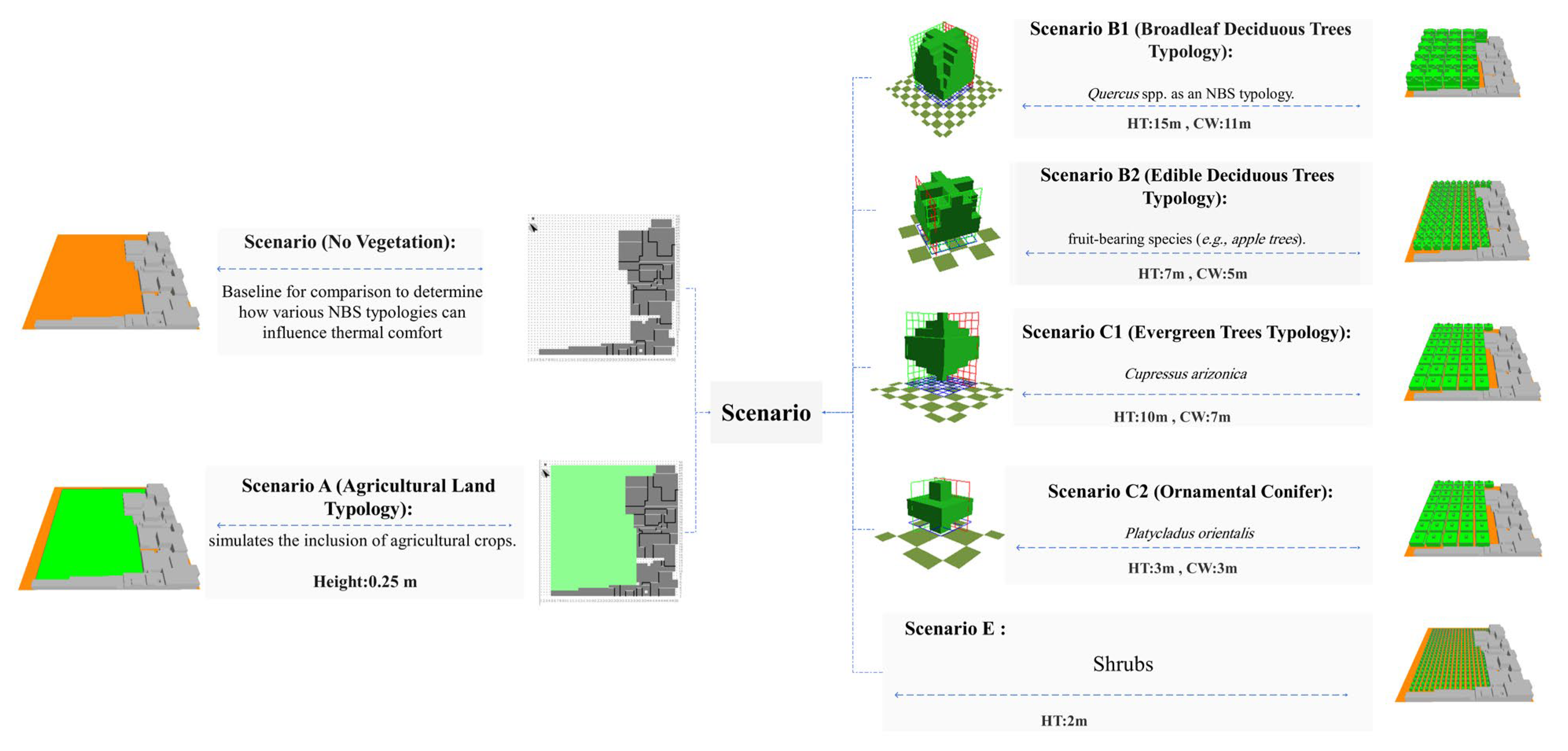
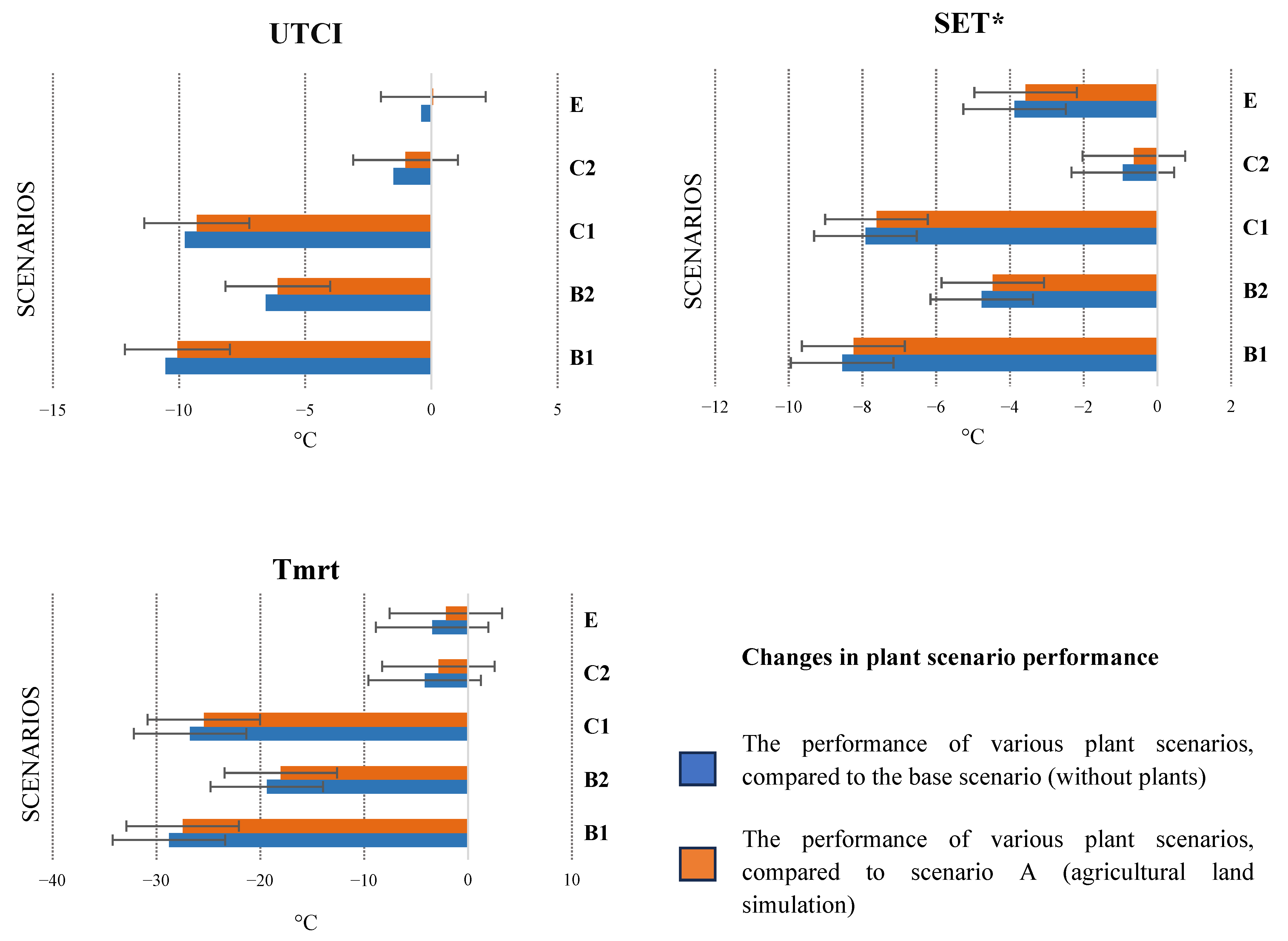
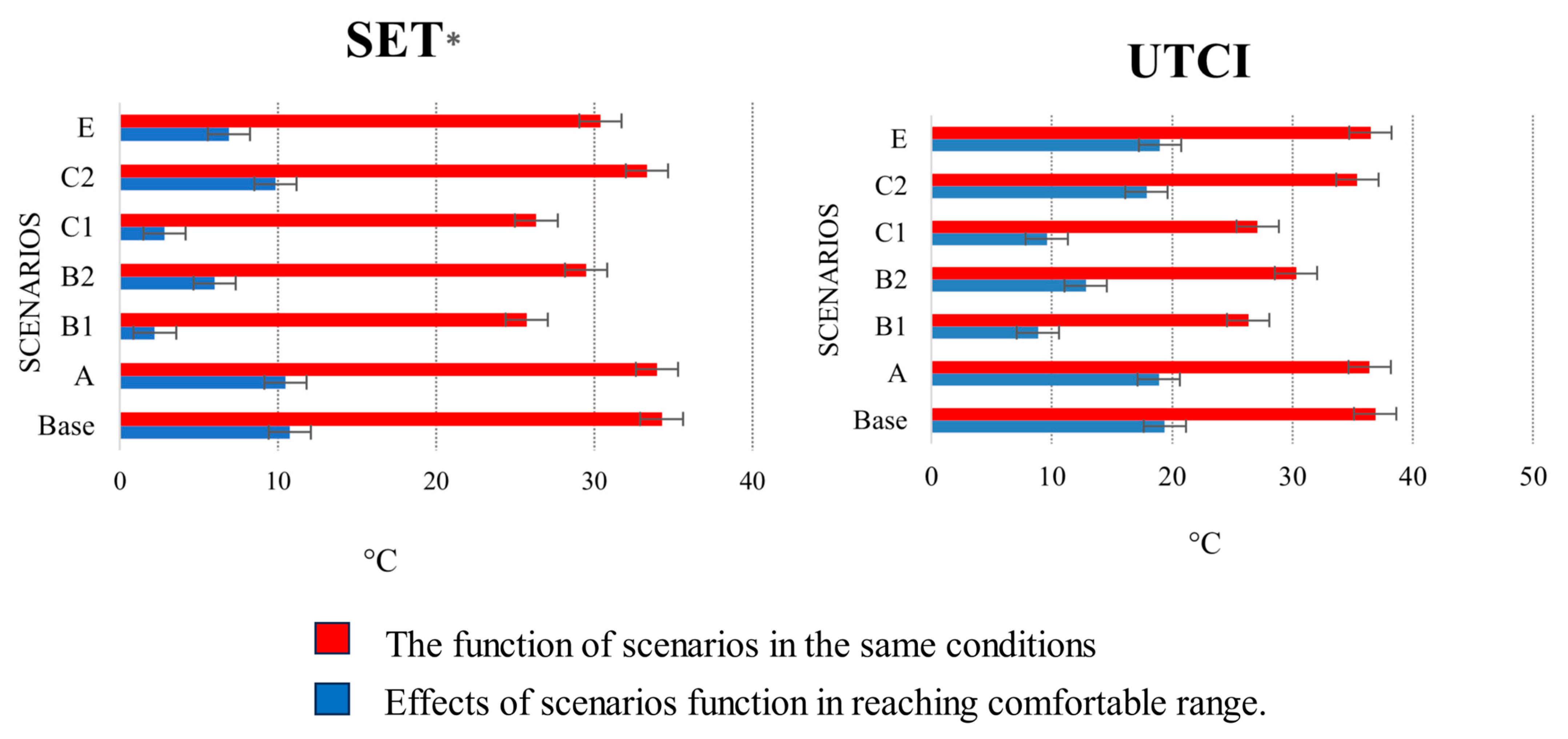
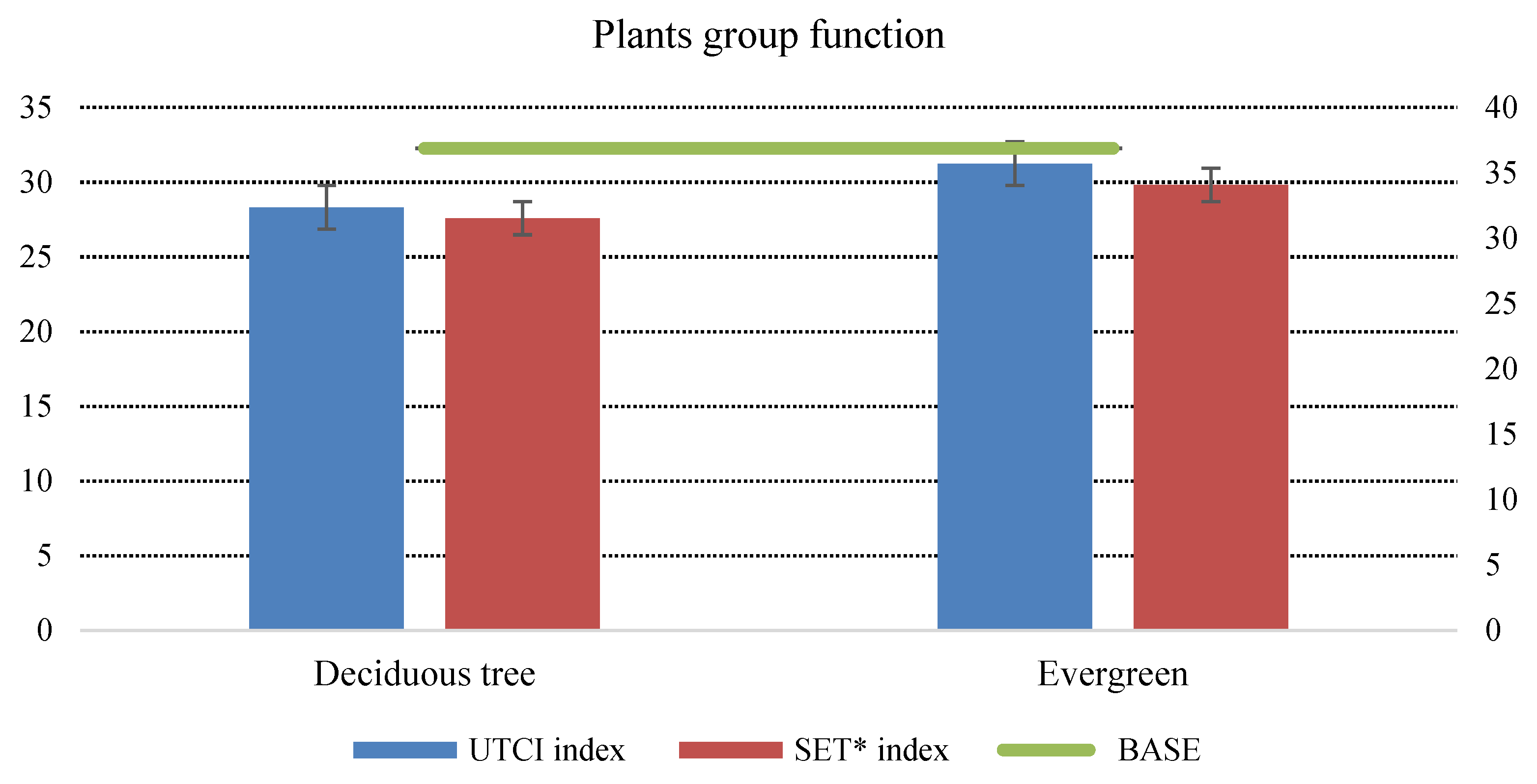
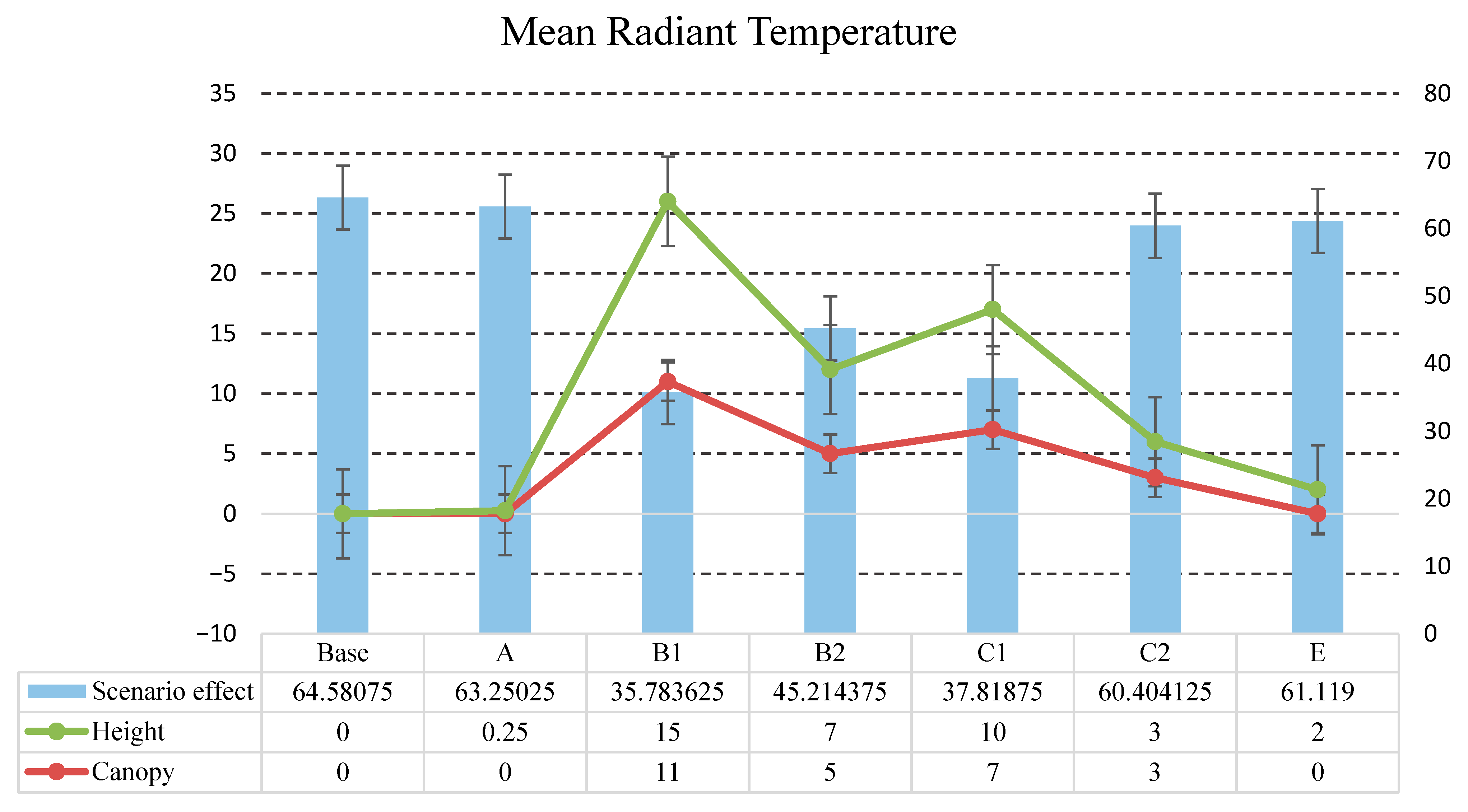
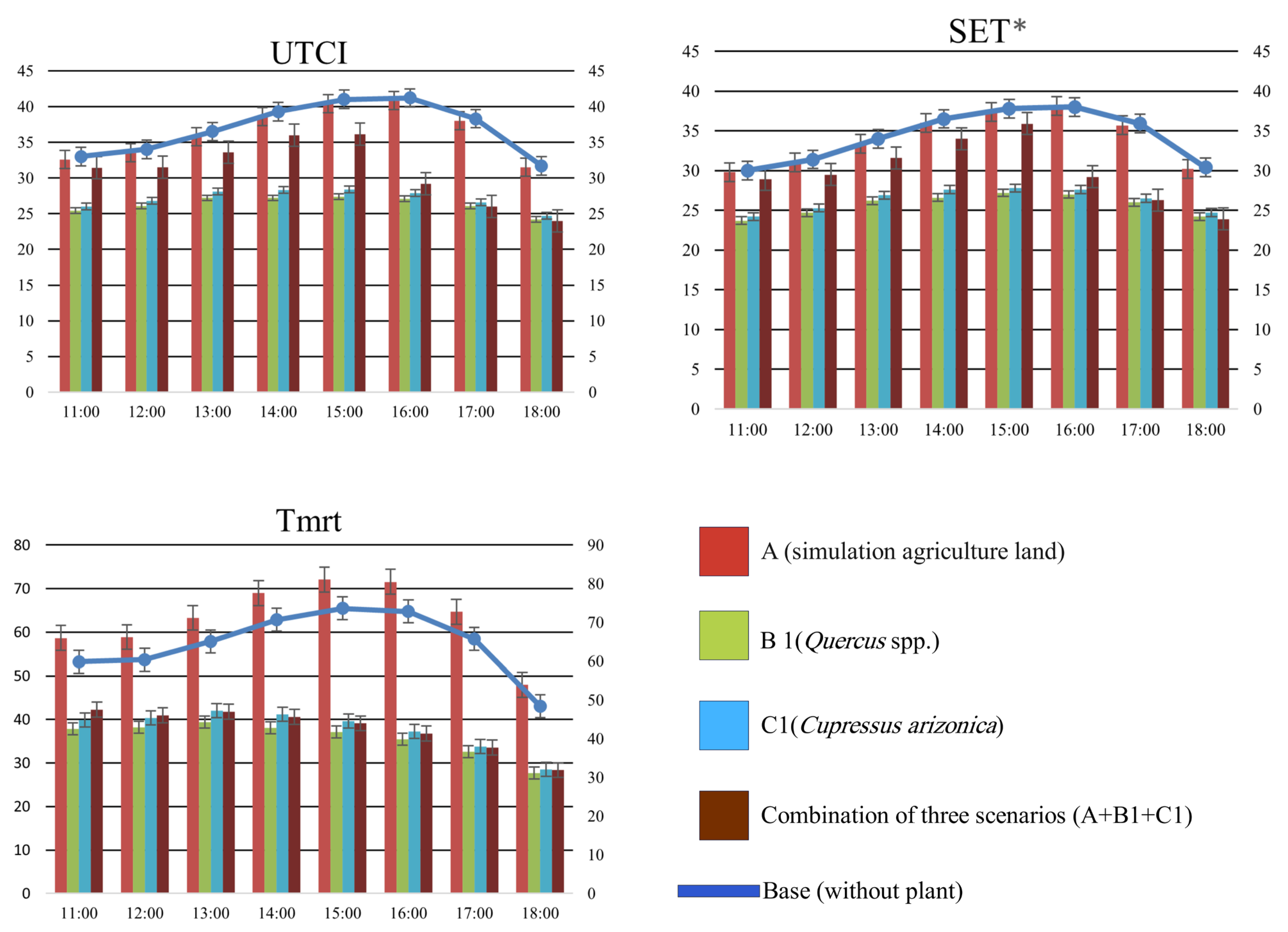
| Parameter | Value |
|---|---|
| Longitude, Latitude | 46°14′43″ E, 38°06′17″ N |
| Horizontal grid resolution | 2 m × 2 m |
| Vertical grid resolution | 2 m |
| Model rotation (from grid north) | 16.6° |
| Simulation data | 30 June 2023 |
| Maximum air temperature | 29.3 °C |
| Minimum air temperature | 18 °C |
| Wind speed at 10 m | 4.8 m/s |
| Wind direction | 90° |
| Wall and Roof Material | Moderate insulation (ENVI-met default) |
| Soil Type | Loamy soil (agriculture) |
| Road Material | Asphalt |
| Scenarios | SET* | Tmrt | UTCI | ||||||
|---|---|---|---|---|---|---|---|---|---|
| RMSE | MAE | d | RMSE | MAE | d | RMSE | MAE | d | |
| A | 0.05 | 0.04 | 1.00 | 0.01 | 0.01 | 1.00 | 0.02 | 0.02 | 1.00 |
| B1 | 0.10 | 0.08 | 0.98 | 0.29 | 0.25 | 0.76 | 0.23 | 0.17 | 0.89 |
| B2 | 0.35 | 0.28 | 0.68 | 0.39 | 0.31 | 0.63 | 0.42 | 0.34 | 0.62 |
| C1 | 0.12 | 0.10 | 0.97 | 0.29 | 0.25 | 0.77 | 0.23 | 0.18 | 0.89 |
| C2 | 0.03 | 0.03 | 1.00 | 0.02 | 0.02 | 1.00 | 0.02 | 0.01 | 1.00 |
| E | 0.09 | 0.07 | 0.99 | 0.01 | 0.01 | 1.00 | 0.25 | 0.15 | 0.87 |
| Combination (A + B1 + C1) | 0.33 | 0.26 | 0.74 | 0.33 | 0.28 | 0.70 | 0.36 | 0.30 | 0.68 |
Disclaimer/Publisher’s Note: The statements, opinions and data contained in all publications are solely those of the individual author(s) and contributor(s) and not of MDPI and/or the editor(s). MDPI and/or the editor(s) disclaim responsibility for any injury to people or property resulting from any ideas, methods, instructions or products referred to in the content. |
© 2025 by the authors. Licensee MDPI, Basel, Switzerland. This article is an open access article distributed under the terms and conditions of the Creative Commons Attribution (CC BY) license (https://creativecommons.org/licenses/by/4.0/).
Share and Cite
Nobar, Z.; Rahimi, A.; Russo, A. Assessing the Potential of Revegetating Abandoned Agricultural Lands Using Nature-Based Typologies for Urban Thermal Comfort. Land 2025, 14, 1938. https://doi.org/10.3390/land14101938
Nobar Z, Rahimi A, Russo A. Assessing the Potential of Revegetating Abandoned Agricultural Lands Using Nature-Based Typologies for Urban Thermal Comfort. Land. 2025; 14(10):1938. https://doi.org/10.3390/land14101938
Chicago/Turabian StyleNobar, Zahra, Akbar Rahimi, and Alessio Russo. 2025. "Assessing the Potential of Revegetating Abandoned Agricultural Lands Using Nature-Based Typologies for Urban Thermal Comfort" Land 14, no. 10: 1938. https://doi.org/10.3390/land14101938
APA StyleNobar, Z., Rahimi, A., & Russo, A. (2025). Assessing the Potential of Revegetating Abandoned Agricultural Lands Using Nature-Based Typologies for Urban Thermal Comfort. Land, 14(10), 1938. https://doi.org/10.3390/land14101938








